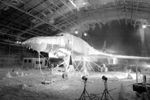
original at www.af.mil |
A B-1B undergoes severe weather testing at the McKinley Climatic Laboratory at Eglin Air Force Base, Fla. The Air Force is playing Mother Nature again after a three-year $75 million series of renovations at the McKinley Climatic Laboratory. Eglin's most famous landmark re-opened June 3 with a dedication ceremony. Present at the ceremony were a P-51 Mustang, the first aircraft tested in the chamber in 1947, and a C-130J, the first aircraft scheduled to be tested in the renovated chamber. Originally constructed during the closing stages of World War II, the laboratory is the only one of its kind in the world. During its 50 years, the lab has frozen, fried and abused more than 350 aircraft, 70 missile support systems and approximately 2,000 equipment items. It has also tested space-bound systems, such as the Apollo space capsule. |
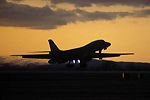
original at www.af.mil |
B-1B Lancer takes off on mission
(U.S. Air Force photo )
The B-1B is a multi-role, long-range bomber, capable of flying intercontinental missions without refueling, then penetrating present and predicted sophisticated enemy defenses. It can perform a variety of missions, including that of a conventional weapons carrier for theater operations. The B-1B's electronic jamming equipment, infrared countermeasures, radar location and warning systems complement its low-radar cross-section and form an integrated defense system for the aircraft. The swing-wing design and turbofan engines not only provide greater range and high speed at low levels but they also enhance the bomber's survivability. Wing sweep at the full-forward position allows a short takeoff roll and a fast base-escape profile for airfields under attack. Once airborne, the wings are positioned for maximum cruise distance or high-speed penetration |
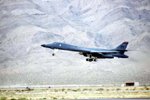
original at www.af.mil |
366th AEW accomplishes 'firsts' while in Bahrain
(U.S. Air Force Photo by Staff Sgt. Lem Robson)
B-1B Lancers, similar to this one, bedded down for the first time with the 366th Air Expeditionary Wing from Mountain Home Air Force Base, Idaho, at a deployed location. |
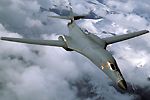
original at www.af.mil |
B-1B Lancer over mountains
(Photo courtesy Ted Carlson, Fotodynamics)
The B-1B is a multi-role, long-range bomber, capable of flying intercontinental missions without refueling, then penetrating present and predicted sophisticated enemy defenses. It can perform a variety of missions, including that of a conventional weapons carrier for theater operations. The B-1B's electronic jamming equipment, infrared countermeasures, radar location and warning systems complement its low-radar cross-section and form an integrated defense system for the aircraft. The swing-wing design and turbofan engines not only provide greater range and high speed at low levels but they also enhance the bomber's survivability. Wing sweep at the full-forward position allows a short takeoff roll and a fast base-escape profile for airfields under attack. Once airborne, the wings are positioned for maximum cruise distance or high-speed penetration |
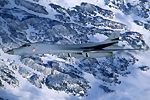
original at www.af.mil |
B-1B low level
(Photo courtesy Ted Carlson, Fotodynamics)
The B-1B is a multi-role, long-range bomber, capable of flying intercontinental missions without refueling, then penetrating present and predicted sophisticated enemy defenses. It can perform a variety of missions, including that of a conventional weapons carrier for theater operations. The B-1B's electronic jamming equipment, infrared countermeasures, radar location and warning systems complement its low-radar cross-section and form an integrated defense system for the aircraft. The swing-wing design and turbofan engines not only provide greater range and high speed at low levels but they also enhance the bomber's survivability. Wing sweep at the full-forward position allows a short takeoff roll and a fast base-escape profile for airfields under attack. Once airborne, the wings are positioned for maximum cruise distance or high-speed penetration |

original at www.af.mil |
B-1s exemplify air power
(Photo by Senior Airman Sean M. White)
A B-1B bomber assigned to Ellsworth Air Force Base, S.D., returns to base after a sortie in Montana. |
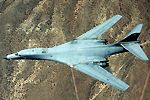
original at www.af.mil |
B-1B Lancer low-level
(U.S. Air Force photo by Staff Sgt. Steve Thurow)
The B-1B is a multi-role, long-range bomber, capable of flying intercontinental missions without refueling, then penetrating present and predicted sophisticated enemy defenses. It can perform a variety of missions, including that of a conventional weapons carrier for theater operations. The first B-1B was delivered to the Air Force at Dyess Air Force Base, Texas, in June 1985, with initial operational capability on Oct. 1, 1986. The final B-1B was delivered May 2, 1988. The B-1B holds several world records for speed, payload and distance. The National Aeronautic Association recognized the B-1B for completing one of the 10 most memorable record flights for 1994. |
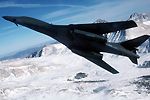
original at www.af.mil |
B-1B Lancer struts it's stuff
(U.S. Air Force photo by Senior Master Sgt. Mike Haggerty)
The B-1B is a multi-role, long-range bomber, capable of flying intercontinental missions without refueling, then penetrating present and predicted sophisticated enemy defenses. It can perform a variety of missions, including that of a conventional weapons carrier for theater operations. The B-1B's electronic jamming equipment, infrared countermeasures, radar location and warning systems complement its low-radar cross-section and form an integrated defense system for the aircraft. The swing-wing design and turbofan engines not only provide greater range and high speed at low levels but they also enhance the bomber's survivability. Wing sweep at the full-forward position allows a short takeoff roll and a fast base-escape profile for airfields under attack. Once airborne, the wings are positioned for maximum cruise distance or high-speed penetration. |
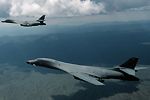
original at www.af.mil |
B-1B Lancers in formation
(U.S. Air Force photo by Staff Sgt. Steve Thurow)
The B-1B is a multi-role, long-range bomber, capable of flying intercontinental missions without refueling, then penetrating present and predicted sophisticated enemy defenses. It can perform a variety of missions, including that of a conventional weapons carrier for theater operations. The B-1B's electronic jamming equipment, infrared countermeasures, radar location and warning systems complement its low-radar cross-section and form an integrated defense system for the aircraft. The swing-wing design and turbofan engines not only provide greater range and high speed at low levels but they also enhance the bomber's survivability. Wing sweep at the full-forward position allows a short takeoff roll and a fast base-escape profile for airfields under attack. Once airborne, the wings are positioned for maximum cruise distance or high-speed penetration. |
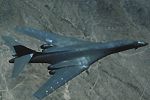
original at www.af.mil |
B-1B Lancer low level
(U.S. Air Force photo)
The B-1B is a multi-role, long-range bomber, capable of flying intercontinental missions without refueling, then penetrating present and predicted sophisticated enemy defenses. It can perform a variety of missions, including that of a conventional weapons carrier for theater operations. The B-1B's electronic jamming equipment, infrared countermeasures, radar location and warning systems complement its low-radar cross-section and form an integrated defense system for the aircraft. The swing-wing design and turbofan engines not only provide greater range and high speed at low levels but they also enhance the bomber's survivability. Wing sweep at the full-forward position allows a short takeoff roll and a fast base-escape profile for airfields under attack. Once airborne, the wings are positioned for maximum cruise distance or high-speed penetration. |
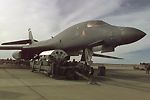
original at www.af.mil |
ODF: B-1 Lancer loaded for deployment
(U.S. Air Force Photo by Staff Sgt. Krista M. Foeller)
A 28th Bomb Squadron B-1 Lancer is loaded with MK-82 bombs as the aircraft is prepared for immediate deployment to the Gulf region in support of Operation Desert Fox. |
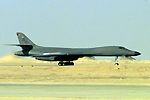
original at www.af.mil |
ODF: B-1 Lancer lifts off
(U.S. Air Force Photo)
A B-1 Lancer from Ellsworth Air Force Base lifts off recently supporting Operation Desert Fox. This is the first operation B-1s have been used for combat. |
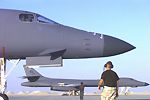
original at www.af.mil |
Desert Fox - B-1Bs prepare to taxi
(U.S. Air Force photo Technical Sgt. Paul Laughhunn)
Dyess AFB, Texas, and Ellsworth AFB, North Dakota, B-1B Lancer bombers prepared to taxi on their first sortie of Operation Desert Fox. |

original at www.af.mil |
B-1B Lancer banks hard right
(U.S. Air Force photo)
The B-1B is a multi-role, long-range bomber, capable of flying intercontinental missions without refueling, then penetrating present and predicted sophisticated enemy defenses. It can perform a variety of missions, including that of a conventional weapons carrier for theater operations. The swing-wing design and turbofan engines not only provide greater range and high speed at low levels but they also enhance the bomber's survivability. Wing sweep at the full-forward position allows a short takeoff roll and a fast base-escape profile for airfields under attack. Once airborne, the wings are positioned for maximum cruise distance or high-speed penetration. |
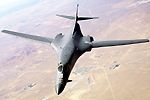
original at www.af.mil |
B-1B Lancer
(U.S. Air Force Photo)
The B-1B is a long-range stategic bomber, capable of flying intercontinental missions without refueling, then penetrating present and future sophisticated enemy defenses. It can perform a variety of missions, including that of a conventional weapons carrier for theater operations. It's electronic jamming equipment, infrared countermeasures, radar location and warning systems complement its low-radar cross-section and form an integrated defense system for the aircraft. |
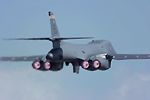
original at www.af.mil |
Allied Force - B-1B takes off from RAF Fairford, England
(U.S. Air Force photo by Senior Airman Jeff Fitch)
A B-1B Lancer from Ellsworth Air Force Base, S.D., takes off from Royal Air Force Fairford, England, on Wednesday, April 28, 1999, on a combat mission in support of Operation Allied Force.B-52H, B-1B and KC-135R aircraft and airmen are forward deployed to Fairford in support of Allied Force. |
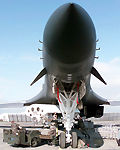
original at www.af.mil |
Ellsworth crew keeping B-1B's loaded with bombs
(U.S. Air Force Photo by Staff Sgt. Randy Mallard)
ROYAL AIR FORCE FAIRFORD, England (AFPN) -- A weapons load crew places a conventional module bomb rack onto a B-1B Lancer long-range strategic bomber here.B-1B Lancers and support personnel from the 28th Bomb Wing at Ellsworth Air Force Base, S.D., are deployed to England and supporting NATO's Operation Allied Force. |

original at www.af.mil |
Up, up and away!
(U.S. Air Force Photo by Staff Sgt. Randy Mallard)
ROYAL AIR FORCE FAIRFORD, England (AFPN) -- A B-1B Lancer takes off from here.B-1B aircraft, crews and support personnel from Ellsworth Air Force Base, S.D., are deployed to England supporting NATO's Operation Allied Force. |
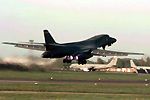
original at www.af.mil |
Up, up and away!
(U.S. Air Force Photo by Senior Airman Jeff Fitch)
ROYAL AIR FORCE FAIRFORD, England (AFPN) -- A B-1B Lancer from Ellsworth Air Force Base, S.D., takes to the sky.B-1B aircraft, crews and support personnel are forward deployed here supporting NATO's Operation Allied Force. |
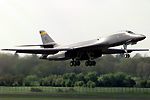
original at www.af.mil |
Allied Force - B-1B takes off from Royal Air Force Fairford, England
(U.S. Air Force Photo by Staff Sgt. Randy Mallard)
A B-1B Lancer, assigned to the 77th Bomb Squadron at Ellsworth Air Force Base, S.D., takes off from Royal Air Force Fairford, England, Monday, May 3, 1999. Aircraft and personnel from the 77th are deployed to England as part of the 2nd Air Expeditionary Group supporting NATO Operation Allied Force. |
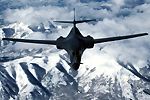
original at www.af.mil |
B-1B Lancer bomber over mountains
(U.S. Air Force Photo)
The B-1B is a multi-role, long-range bomber, capable of flying intercontinental missions without refueling, then penetrating present and predicted sophisticated enemy defenses. It can perform a variety of missions, including that of a conventional weapons carrier for theater operations. |
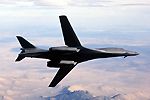
original at www.af.mil |
A B-1B Lancer flies a test mission
()U.S. Air Force Photo by Staff Sgt. Mark A. Borsch
A B-1B Lancer from the 37th Bomb Squadron, 28th Bomb Wing, Ellsworth Air Force Base, S. D., flies a test mission over the dry lakebeds of southern California. The Lancer was part of the ongoing weapons flight-testing program at Edwards Air Force Base, Calif. Over 5,000 hours a year are flown to support these test programs. |
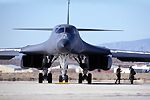
original at www.af.mil |
B-1B Lancer readys for mission at Edwards AFB, Calif.
(U.S. Air Force Photo by Staff Sgt. Mark Borosch)
The B-1B is a long-range strategic bomber, capable of flying intercontinental missions without refueling, then penetrating present and future sophisticated enemy defenses. It can perform a variety of missions, including that of a conventional weapons carrier for theater operations. The B-1B's electronic jamming equipment, infrared countermeasures, radar location and warning systems complement its low-radar cross-section and form an integrated defense system for the aircraft. The swing-wing design and turbofan engines not only provide greater range and high speed at low levels but they also enhance the bomber's survivability. Wing sweep at the full-forward position allows a short takeoff roll and a fast base-escape profile for airfields under attack. Once airborne, the wings are positioned for maximum cruise distance or high-speed penetration. The B-1B uses radar and inertial navigation equipment enabling aircrews to globally navigate, update mission profiles and target coordinates in-flight, and precision bomb without the need for ground-based navigation aids. Included in the B-1B offensive avionics are modular electronics that allow maintenance personnel to precisely identify technical difficulties and replace avionics components in a fast, efficient manner on the ground. |
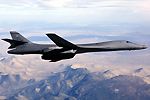
original at www.af.mil |
B-1B Lancer flies a test mission over southern California
(U.S. Air Force Photo by Staff Sgt. Mark Borosch)
The B-1B is a long-range strategic bomber, capable of flying intercontinental missions without refueling, then penetrating present and future sophisticated enemy defenses. It can perform a variety of missions, including that of a conventional weapons carrier for theater operations. The B-1B's electronic jamming equipment, infrared countermeasures, radar location and warning systems complement its low-radar cross-section and form an integrated defense system for the aircraft. The swing-wing design and turbofan engines not only provide greater range and high speed at low levels but they also enhance the bomber's survivability. Wing sweep at the full-forward position allows a short takeoff roll and a fast base-escape profile for airfields under attack. Once airborne, the wings are positioned for maximum cruise distance or high-speed penetration. The B-1B uses radar and inertial navigation equipment enabling aircrews to globally navigate, update mission profiles and target coordinates in-flight, and precision bomb without the need for ground-based navigation aids. Included in the B-1B offensive avionics are modular electronics that allow maintenance personnel to precisely identify technical difficulties and replace avionics components in a fast, efficient manner on the ground. |
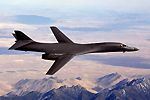
original at www.af.mil |
A B-1B Lancer flys a test mission
(U.S. Air Force Photo by Staff Sgt. Mark Borosch)
A B-1B Lancer from the 37th Bomb Squadron, 28th Bomb Wing, Ellsworth Air Force Base, S. D., flys a test mission over the dry lakebeds of southern California. The Lancer was part of the ongoing weapons flight-testing program at Edwards Air Force Base, Calif. Over 5,000 hours a year are flown to support these test programs. |

original at www.af.mil |
B-1 "Bomber Forward Presence" in Korea
(U.S. Air Force Photo by Senior Airman Andy Bellamy)
Bomber pilots climbed into a B-1B "Lancers" from Dyess Air Force Base, Texas, and demonstrated "Bomber Forward Presence." This is the Air Force's ability to reach out and touch the world during a Global Power mission to the Republic of Korea. The mission, named Coronet Spider 27, tasked two bombers from the 9th Bomb Squadron to conduct training as a complete strike package with Osan A-10s and F-16s and F-15s from Kadena Air Base, Japan. |
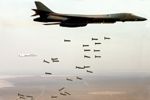
original at www.af.mil |
B-1B Lancer drops cluster munitions
(U.S. Air Force Photo)
The B-1B Lancer is a long-range strategic bomber, capable of flying intercontinental missions without refueling, then penetrating present and future sophisticated enemy defenses. It can perform a variety of missions, including that of a conventional weapons carrier for theater operations. The B-1B's electronic jamming equipment, infrared countermeasures, radar location and warning systems complement its low-radar cross-section and form an integrated defense system for the aircraft. The swing-wing design and turbofan engines not only provide greater range and high speed at low levels but they also enhance the bomber's survivability. Wing sweep at the full-forward position allows a short takeoff roll and a fast base-escape profile for airfields under attack. Once airborne, the wings are positioned for maximum cruise distance or high-speed penetration. The B-1B uses radar and inertial navigation equipment enabling aircrews to globally navigate, update mission profiles and target coordinates in-flight, and precision bomb without the need for ground-based navigation aids. Included in the B-1B offensive avionics are modular electronics that allow maintenance personnel to precisely identify technical difficulties and replace avionics components in a fast, efficient manner on the ground. |
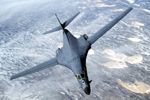
original at www.af.mil |
B-1B Lancer over Wyoming
(U.S. Air Force Photo by Staff Sgt. Douglas Brunelle)
The B-1B is a long-range strategic bomber, capable of flying intercontinental missions without refueling, then penetrating present and future sophisticated enemy defenses. It can perform a variety of missions, including that of a conventional weapons carrier for theater operations. The B-1B's electronic jamming equipment, infrared countermeasures, radar location and warning systems complement its low-radar cross-section and form an integrated defense system for the aircraft. The swing-wing design and turbofan engines not only provide greater range and high speed at low levels but they also enhance the bomber's survivability. Wing sweep at the full-forward position allows a short takeoff roll and a fast base-escape profile for airfields under attack. Once airborne, the wings are positioned for maximum cruise distance or high-speed penetration. The B-1B uses radar and inertial navigation equipment enabling aircrews to globally navigate, update mission profiles and target coordinates in-flight, and precision bomb without the need for ground-based navigation aids. Included in the B-1B offensive avionics are modular electronics that allow maintenance personnel to precisely identify technical difficulties and replace avionics components in a fast, efficient manner on the ground. |
^^ TOP ^^
|

